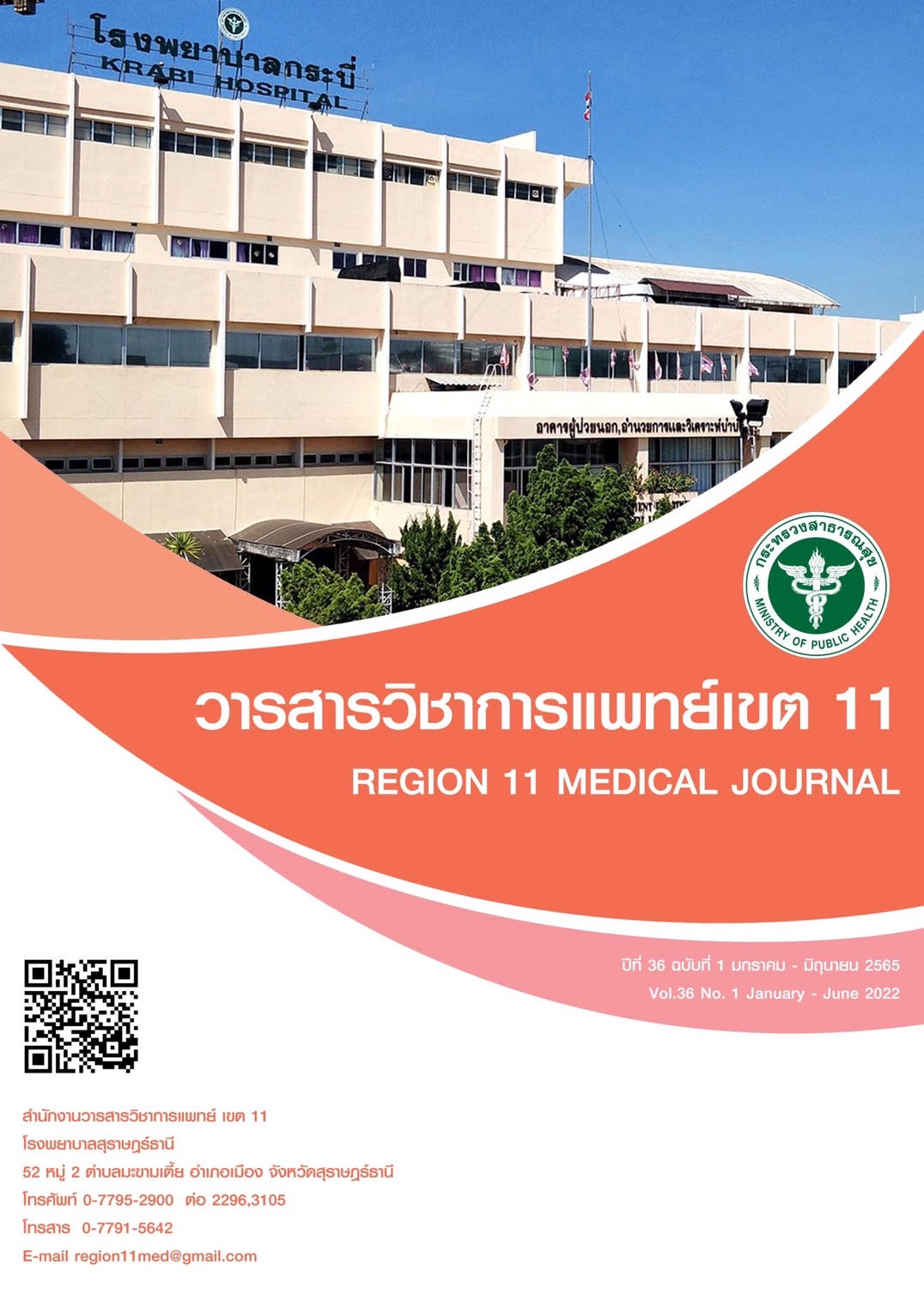Incidence and Associated Factors of Hearing disorder in Newborns at Sichon Hospital Nakhon Si Thammarat Province
Keywords:
Hearing Disorders, neonatal outcome, Hearing ScreeningAbstract
Background: Neonatal congenital hearing disorders can be affected the development of language, speech and other aspects of children both present and in the future. Therefore, the study of incidence and factors associated with the occurrence of hearing impairment will be able to develop a method for finding such anomalies and can help the baby at the beginning.
Objective: To study incidence and factors associated with the occurrence of hearing disorder in newborns at Sichon Hospital, Nakhon Si Thammarat
Methods: A retrospective study design were adopted for this study. Data were recruited from the medical records of all newborns who were born in Sichon Hospital from January 1, 2018 to December 31, 2019, a total of 1,952 cases. Data collection is recorded by using the record form of hearing screening test for newborn babies in Sichon Hospital, Nakhon Si Thammarat province. Data were analyzed by using descriptive statistics and chi-square.
Results: Most of the babies (50.2%) were male (50.2%), born NL (48.8%), and the majority were normal (88.3%) with an Apgar Score at minutes 1, 5 and 10 of 8-10. (97.9%, 99.8% and 100%). Data showed the mean gestational age of babies around 38 ± 1.5 weeks birth weight approximately 3,063± 468.5 gm (Min = 1,110, Max = 5,480). The incidence of hearing disorder among newborns was 6.66 per 1,000 live births, 4.6 per 1,000 in normal infants and 22.1 per 1,000 among at risk infants. The top 3 most common hearing disorder factors were 195 cases who spent more than 5 days in the neonatal intensive care unit, 126 cases were received gentamycin ear antibiotics and 12 cases of newborn had family member history about congenital hearing disorder. Additionally, gestational age, birth weight, Apgar score at 1st minute and a group of infants were significantly associated with newborn hearing impairment at level 0.05.
Conclusion: The incidence of hearing disorders in risk infants was higher than normal infants. Therefore, screening for all newborn infants should be aware of the hearing disorder, especially, babies born prematurely, low birth weight, and with hypoxia at birth.
References
Wroblewska-Seniuk KE, Dabrowski P, Szyfter W & Mazela J. Universal Newborn Hearing Screening: Methods and Results, Obstacles and Benefits. Pediatr Res. 2017;81(3):415-22.
Kumar A, Gupta SC & Sinha VR. Universal hearing screening in newborn using otoacoustic emission and brainstem evoked response in Eastern Uttar Pradesh. Indian J Otolaryngol Head Neck Surg. 2017;69(3):296-9.
Ahmed S, et al. Frequency of congenital hearing loss in neonates. J Ayub Med Coll Abbottabad. 2018;30(2):234-6.
รุ่งกานต์ เพชรล้วน. อุบัติการณ์ของการสูญเสียการได้ยินในทารกตรวจคัดกรองด้วยเครื่องตรวจวัดเสียงสะท้อนจากหูชั้นใน โรงพยาบาลตะกั่วป่า. Krabi medical journal. 2563; 3(1):1-8.
Ezzeldin ZM, Sharaf E, Hamdy S & Abdelwahab Selim YA. Hearing screeningin neonates with hyperbillrubinemia. Int J Pediatr Otorhinopharyngol. 2021; 142:110591.
ตฤษนันท์ แซ่แต้. การคัดกรองการได้ยินในทารกแรกเกิดที่มีปัจจัยเสี่ยงสูงของโรงพยาบาลชุมพรเขตอุดมศักดิ์. วารสารวิชาการแพทย์ เขต 11. 2559;30(2):31-6.
ศิริวัฒน์ ธัญสิริพงศ์. การตรวจคัดกรองการได้ยินในทารกแรกเกิดด้วยเครื่องตรวจวัดเสียงสะท้อนจากหูชั้นในของโรงพยาบาลระนอง. วารสารวิชาการแพทย์ เขต 11. 2560;31(2):211-21.
Stadio AD et al. Sensorineural Hearing Loss in Newborns Hospitalized in Neonatal Intensive Care Unit: An Observational Study. Int Tinnitus J. 2019;23(1):31-6.
ชัยรัตน์ เสรีรัตน์ และวิภาดา เสรีรัตน์. การตรวจคัดกรองการได้ยินในทารกเกิดกลุ่มเสี่ยงในหอผู้ป่วยวิกฤตทารกแรกเกิดโรงพยาบาลร้อยเอ็ด. ศรีนครินทร์เวชสาร. 2564; 36(1):39-47.
Schwarz Y, Kaufman GN & Daniel SJ. Newborn hearing screening failure and maternal factors during pregnancy. Int J Pediatr Otorhinopharyngol. 2017; 103:.65-7.
Kaveh M, Mirjalali SN, Shariat M & Zarkesh MR. Perinatal factors influencing the neonatal hearing screening results. BMC Pediatr. 2021;21(1):15.
Shahid R, Vigilante M, Deyro H, Reyes I, Gonzalez B & Kliethermes S. Risk factors for failed newborn otoacoustic emissions hearing screen. Clin Pediatr. 2016;55(12):1138-42.
Garinis AC et al. Effect of Gentamycin and level of ambient sound on hearing screening outcomes in the neonatal intensive care unit: A pilot study. Int J Pediatr Otorhinopharyngol. 2017; 42-50.
Yang HC, Sung CM, Shin DJ, Cho YB, Jang CH & Cho HH. Newborn hearing screening in prematurity: Fate of screening failures and auditory maturation. Clin Otolarygol. 2017;42(3):661-67.
Sevenko IV, Garbaruk ES & Krasovskaya EA. Changes in auditory function in premature children: A prospective cohort study. Int J Pediatr Otorhinopharyngol. 2020; 139.
Jadia S, Qureshi S, Raghuwanshi P & Sharma S. Role of otoacoustic emissions in hearing assessment of neonates: A prospective observation study. Indian J Otolaryngol Head Neck Surg. 2019;71(Supply 2): 1187-89.
Amini E, et al. Assessment of hearing loss by OAE in Asphyxiated Newborn. Iran Red Cres Med J. 2014;16(1):e6812.
Downloads
Published
How to Cite
Issue
Section
License
Copyright (c) 2022 Region11Medical Journal

This work is licensed under a Creative Commons Attribution-NonCommercial-NoDerivatives 4.0 International License.






